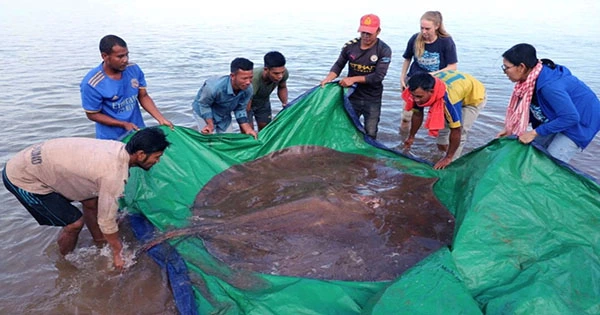The world’s largest freshwater fish, a massive stingray the size of a grand piano, has been caught and released in northeast Cambodia’s Mekong River. Following a tip from local fishermen the night before, a team of scientists from the Wonders of Mekong study project assisted in catching, tagging, and measuring the ray before it was put back into the river on June 14, according to FISHBIO.
From snout to stinger, the female big freshwater stingray (Urogymnus polylepis) weighed 300 kilograms (661 pounds) and was 2.2 meters broad by 4 meters long (7 foot 2 inches by 13 feet 1 inch). This weigh-in established her as the world’s largest freshwater fish, surpassing the previous record of 293 kilos held by a Mekong giant catfish (Pangasianodon gigas) caught in 2005. (645 pounds).
A tiny surgical incision was made at the base of the ray’s tail to place the little tag. This will send acoustic signals to 36 retrievers throughout the Mekong and other neighboring waterways, allowing them to follow the animal’s movement and migration. This massive species may be found lurking in Southeast Asia’s and Borneo’s huge rivers and estuaries. Despite the fact that its sting is wrapped in deadly mucous that can pierce bone, it is typically regarded as a gentle giant that only attacks people when provoked.
The huge freshwater stingray, like many other Southeast Asian large fish, is endangered. The species is listed as endangered by the IUCN Red List of Threatened Species after being more threatened by pollution, climate change, human development, and overfishing. Many Mekong fish species migrate long distances as part of their life cycles to reach different floodplains, deep pools, and flooded forests, which is why the tag connected to this massive beauty is so significant. Researchers are keen to discover where and when certain species go on their journeys so they may learn how to conserve these settings and, in turn, its residents.
“Big fish are critically endangered all around the world. They’re a rare and valuable species. It takes a long time for them to mature. So if they’re caught before they reach sexual maturity, they won’t be able to breed “NPR spoke with Zeb Hogan, the director of the Wonders of the Mekong project at the University of Nevada in Reno’s Department of Biology. “Because a lot of these huge fish are migratory, they require a lot of space to live.” They’re harmed by habitat fragmentation caused by dams, and they’re plainly harmed by overfishing. As a result, 70 percent of the world’s biggest freshwater fish, as well as all Mekong species, are endangered.” “The fact that the fish can still grow to this size is a positive indicator for the Mekong River,” Hogan continued.













